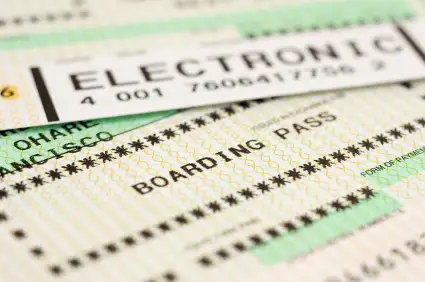
A reader recently asked, “What do those letters on my airline ticket mean?”
Generally speaking, they refer to the type of fare you paid—first class, business class, and so forth. But since this is the airline industry we’re talking about, no explanation can be that simple. Within each fare class are numerous subclasses the airlines use to track exactly what sort of ticket you purchased.
Here’s the International Air Transport Association’s (IATA) official list of fare codes. Not all airlines follow this list exactly, but most are pretty close:
First Class
R Supersonic
P First Class Premium
F First Class
A First Class Discounted
Business Class
J Business Class Premium
C Business Class
D, I, Z Business Class Discounted
Economy/Coach Class
W Economy/Coach Premium
S, Y Economy/Coach
B, H, K, L, M, N, Q, T, V, X Economy/Coach Discounted
Further, additional codes indicate seasonality, day of week, time of day, and a whole host of other qualifiers.
There are two primary ways these codes affect your travels. One, which frequent flyers know well, is upgrade eligibility. Some fare classes are easier to upgrade than others. United, for example, posts an enormous chart detailing which codes are eligible for what kinds of upgrades. Each airline has its own policy, so check with your carrier to see which codes require the most miles and/or cash to move up to the front cabin. Some economy fare classes, called Y-UP and sometimes Q-UP, can be upgraded for free by anyone, but they’re tricky to find and pricey (though considerably cheaper than first-class fares).
On the other end of the spectrum, passengers flying in lower fare classes are more vulnerable to being bumped. According to the Department of Transportation (DOT), “Airlines set their own ‘boarding priorities,’ the order in which they will bump different categories of passengers in an oversale situation. When a flight is oversold and there are not enough volunteers, some airlines bump passengers with the lowest fares first. Others bump the last passengers to check in.” If you’ve booked a super-discounted fare, such as a name-your-own-price ticket, you’ll probably be in the lowest fare class and, therefore, be more vulnerable to being bumped. Your best defense, in that case, is to check in early.
The only way to get a better code, of course, is to pay for it. Typically the cheapest fares are also the lowest fare class, which come with the most restrictions and, as mentioned above, the least security. If you want to book in a higher fare class, and likely get a ticket that’s more flexible and refundable than a discounted one, most airlines will let you search by fare class from the “advanced booking” page.
Got more travel-related questions? Send them in or leave a comment below, and your query could show up in the next Reader Q&A!
We hand-pick everything we recommend and select items through testing and reviews. Some products are sent to us free of charge with no incentive to offer a favorable review. We offer our unbiased opinions and do not accept compensation to review products. All items are in stock and prices are accurate at the time of publication. If you buy something through our links, we may earn a commission.
Related
Top Fares From
Today's Top Travel Deals
Brought to you by ShermansTravel
Shop and Save with Country Inns...
Patricia Magaña
 Hotel & Lodging Deals
Hotel & Lodging Deals
$229 -- Chicago: Discounted Rates and...
Francesca Miele
 Hotel & Lodging Deals
$229+
Hotel & Lodging Deals
$229+
$188 -- Honolulu: Save on Oceanview...
Abigail Lamay
 Hotel & Lodging Deals
$188+
Hotel & Lodging Deals
$188+



